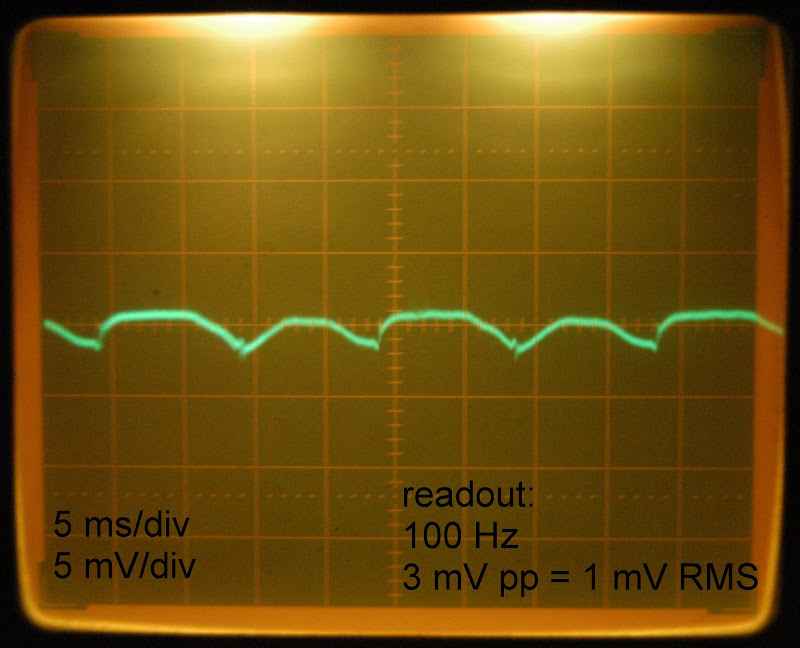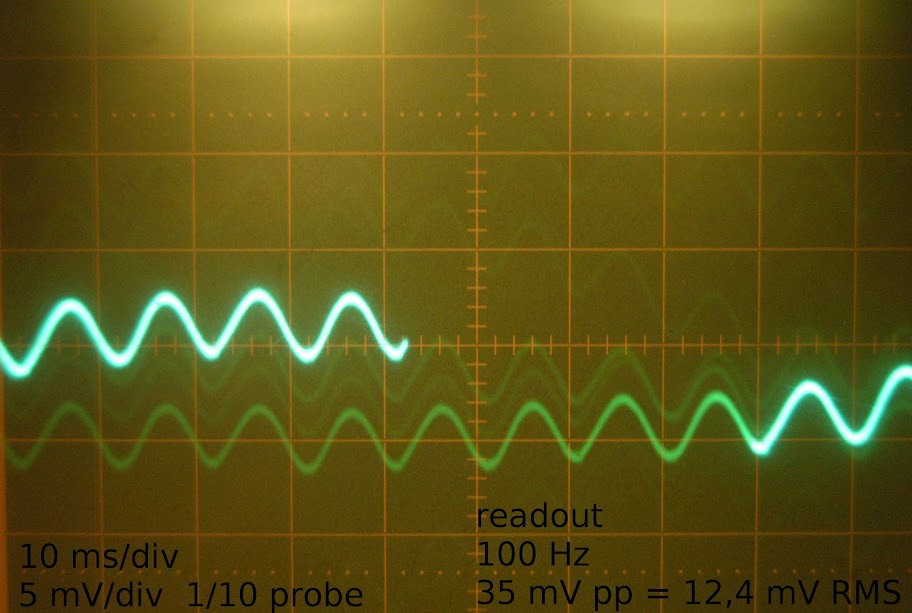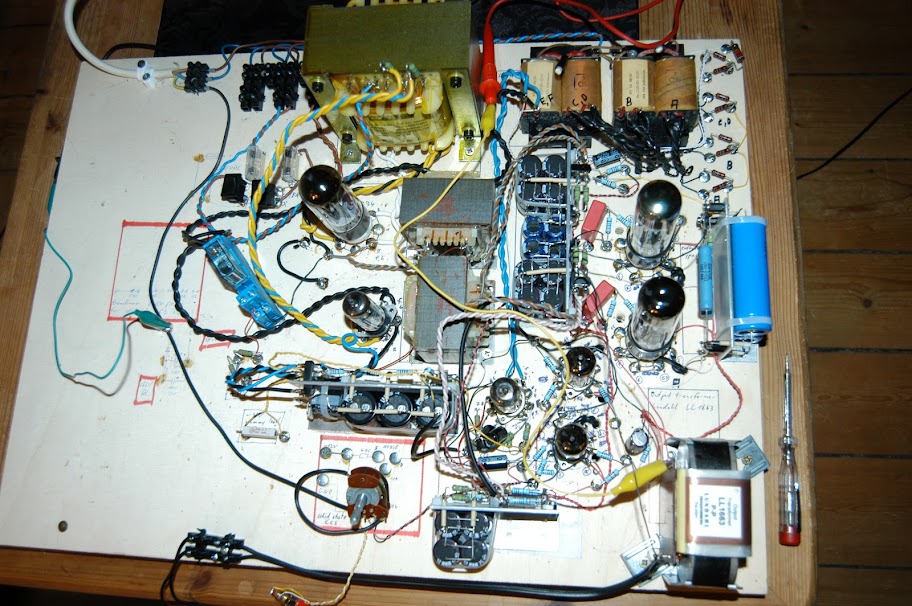Hey there,
I made some changes to the grounding scheme yesterday, the hum level is now significantly lower.
The remaining hum disappears instantly on switching off the mains - so it's heater hum or PSU ripple. In principle, both should be distinguishable by the frequency, 100Hz for PSU ripple, 50Hz for heaters, am I right?
Anyway, I am able to switch the mains for the HV supply and the heaters independently, so I can just try and find out which one makes the hum disappear instantly. Just forgot about that simple test yesterday, maybe it was a little too late in the evening 😉
Andreas
I made some changes to the grounding scheme yesterday, the hum level is now significantly lower.
The remaining hum disappears instantly on switching off the mains - so it's heater hum or PSU ripple. In principle, both should be distinguishable by the frequency, 100Hz for PSU ripple, 50Hz for heaters, am I right?
Anyway, I am able to switch the mains for the HV supply and the heaters independently, so I can just try and find out which one makes the hum disappear instantly. Just forgot about that simple test yesterday, maybe it was a little too late in the evening 😉
Andreas
There are a number of hum ingress mechanisms - some have f fundamental, some have 2f fundamental. Sometimes its the harmonics of 2f that are most noticeable.
Measurements
Hey there,
I found time to get the scope out today, and found the following:
Output hum into 8ohms:

So there's roughly 1mV RMS hum into 8ohms on the output, with a frequency of 100Hz. Note the strange waveform: The hum is not sinusoidal, but looks like a full-wave rectified AC instead. There are short 'spikes' at the lowest parts of the waveform, too...
Anyone seen such a waveform on the output of an amplifier before? Ideas about the origin of the hum?
Checked the B+ rail for excessive ripple, but the 12mV RMS ripple I measured there seem reasonable:

Sorry for the low image quality, multiple traces due to slow exposure time and low-frequency rail variations...
Greetings,
Andreas
Hey there,
I found time to get the scope out today, and found the following:
Output hum into 8ohms:
So there's roughly 1mV RMS hum into 8ohms on the output, with a frequency of 100Hz. Note the strange waveform: The hum is not sinusoidal, but looks like a full-wave rectified AC instead. There are short 'spikes' at the lowest parts of the waveform, too...
Anyone seen such a waveform on the output of an amplifier before? Ideas about the origin of the hum?
Checked the B+ rail for excessive ripple, but the 12mV RMS ripple I measured there seem reasonable:
Sorry for the low image quality, multiple traces due to slow exposure time and low-frequency rail variations...
Greetings,
Andreas
Perhaps try a battery supply for input heaters - that would be my first check.
Hi,
forgot to mention the following:
a) Hum is instantly away when switching off the mains for the HV transformer
b) Hum waveform remains unchanged when switching off the heater mains for a short moment.
Andreas
Hmmm, for a common PT I'd try a humdinger pot on the heater - the mechanism of HT rectifier waveform coupling to heater winding is still valid for (a) and (b).
But I think you have two separate transformers?
But I think you have two separate transformers?
Hmmm, for a common PT I'd try a humdinger pot on the heater - the mechanism of HT rectifier waveform coupling to heater winding is still valid for (a) and (b).
But I think you have two separate transformers?
Hey there,
in fact, the test setup uses three different transformers:
1. 480-0-480, 180-0-180, 5 (+HV, -HV, rect. heater)
2. 6.3, 6.3 (-HV rect. heater, ECC88)
3. 6.3, 6.3 (EL34)
The waveform of the hum very much looks like the current/voltage waveform I would expect between rectifier and 1st filter. I did not use twisted leads when setting up the power supply, maybe the rect.-filter connection couples into some high-impedance stuff in the amp circuit...
Andreas
Were the scope shots with both inputs shorted to gnd? Have you checked some other simple circuitry 'exclusions' - eg. grounding the output stage signal inputs; replacing ccs with standard bypassed resistor. Then maybe DC heater, or humdinger pot.
Hey there,
They were made with the positive input shorted at the volume pot. The negative input is shorted to ground by default, as I do not have symmetric signal sources.
One test I performed was taking out the interlock relay for the negative rail, disabling the CCS. So no amplification in the input/PI stage. Hum was unchanged.
Can I simply ground the grids of the output stage for testing?
Greetings,
Andreas
Were the scope shots with both inputs shorted to gnd?
They were made with the positive input shorted at the volume pot. The negative input is shorted to ground by default, as I do not have symmetric signal sources.
Have you checked some other simple circuitry 'exclusions' - eg. grounding the output stage signal inputs; replacing ccs with standard bypassed resistor
One test I performed was taking out the interlock relay for the negative rail, disabling the CCS. So no amplification in the input/PI stage. Hum was unchanged.
Can I simply ground the grids of the output stage for testing?
Greetings,
Andreas
Hey there,
the hum is gone, finally! Need to check it with a scope, but it was no longer audible, not even via the large speakers of my main system.
The asymmetric hum waveform remarkably resembled the current waveform between rectifier and 1st filter cap, so I assumed some magnetic coupling from there into some sensitive grid circuit.
Made the following changes:
The original wiring had large loops between B+ wiring and ground returns. I changed the power supply wiring as follows: The two wires from the HV secondary to the rectifier have been twisted tightly, together with the return wire to the center tap. From the rectifier, the wires remain twisted all the way to the 1st choke, 1st filter cap, 2nd choke, 2nd cap, 3rd cap.
A new grounding scheme was introduced: A ground bus of 0.75mm² (see above) from the transformer CT to the last filter cap. All ground lines from different amplifier parts return directly to the filter cap feeding that part of the circuit. Audio ground connected to mains earth at the input socket.
Hooked everything up to the main speakers because I was so excited - very nice sound with significantly more bass than expected. Will dig out the scope and signal generator and make some measurements that are more meaningful than 'nice sound'.
Rundmaus 🙂
Aaah. A picture:

See https://picasaweb.google.com/lh/photo/4lZDBb78M8-QekdmQBOmn42R4HGAUWFuVWcbsPRdpOg?feat=directlink for full resolution.
the hum is gone, finally! Need to check it with a scope, but it was no longer audible, not even via the large speakers of my main system.
The asymmetric hum waveform remarkably resembled the current waveform between rectifier and 1st filter cap, so I assumed some magnetic coupling from there into some sensitive grid circuit.
Made the following changes:
The original wiring had large loops between B+ wiring and ground returns. I changed the power supply wiring as follows: The two wires from the HV secondary to the rectifier have been twisted tightly, together with the return wire to the center tap. From the rectifier, the wires remain twisted all the way to the 1st choke, 1st filter cap, 2nd choke, 2nd cap, 3rd cap.
A new grounding scheme was introduced: A ground bus of 0.75mm² (see above) from the transformer CT to the last filter cap. All ground lines from different amplifier parts return directly to the filter cap feeding that part of the circuit. Audio ground connected to mains earth at the input socket.
Hooked everything up to the main speakers because I was so excited - very nice sound with significantly more bass than expected. Will dig out the scope and signal generator and make some measurements that are more meaningful than 'nice sound'.
Rundmaus 🙂
Aaah. A picture:
See https://picasaweb.google.com/lh/photo/4lZDBb78M8-QekdmQBOmn42R4HGAUWFuVWcbsPRdpOg?feat=directlink for full resolution.
Yes, many will happily twist heater windings and lay them with great care and attention, but not perhaps appreciate the other high current AC wiring in an amp (anything to do with rectifier currents, and OT primaries and secondaries and the primary side current loop that includes the power supply filter and output stage tubes).
Last edited:
- Status
- Not open for further replies.
- Home
- Amplifiers
- Tubes / Valves
- Locating hum source